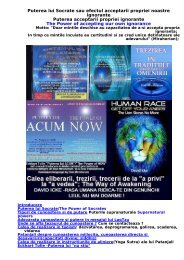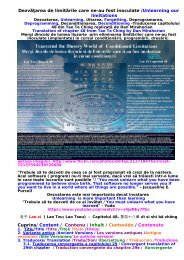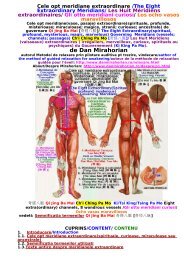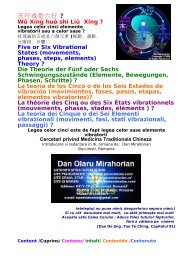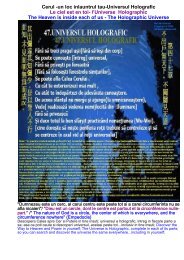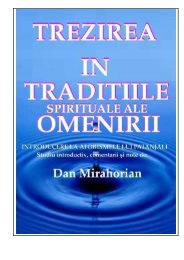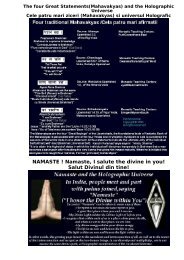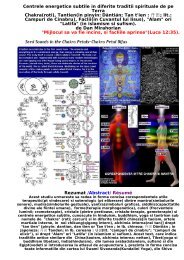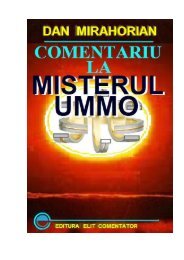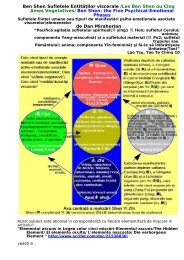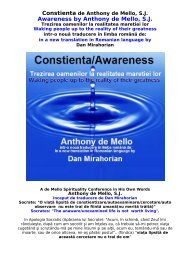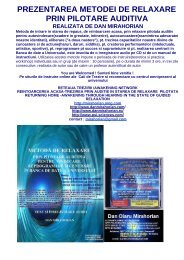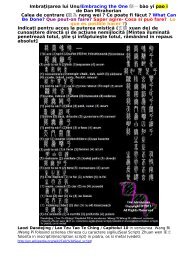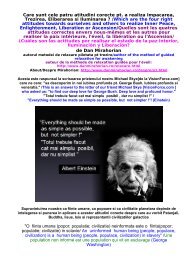Udana Vayu: localizare :gat si cap; centru ... - Dan Mirahorian
Udana Vayu: localizare :gat si cap; centru ... - Dan Mirahorian
Udana Vayu: localizare :gat si cap; centru ... - Dan Mirahorian
Create successful ePaper yourself
Turn your PDF publications into a flip-book with our unique Google optimized e-Paper software.
<strong>si</strong>ddhis (divine, extraordinary or supernatural powers): by regulating this energy can be<br />
obtained the teleportation, levitation and invulnerability(defen<strong>si</strong>ve shield) ; give a sense of<br />
lightness or levitation (subtle <strong>Udana</strong>);<br />
Prana <strong>Vayu</strong>: <strong>localizare</strong> :chest/heart; field of activity: from the heart to the throat; Prana<br />
<strong>Vayu</strong> governs the movement of energy from the head down to the navel, which is the<br />
Pranic center in the phy<strong>si</strong>cal body;It moves between the nostrils and the heart during<br />
inhalation / exhalation; the breath called Prana, the bearer of a current of heat, descends<br />
from the head downwards to the extremity of the anal canal and thence is sent upwards<br />
once more. Coming back to its seat in the head, it once more sends down the heat it<br />
bears. Below the navel is the region of digested matter. Above it is that for the food which<br />
is taken. In the navel are all the forces of life that sustain the body.<br />
function : main function is respiration; Prana governs the intake of substances; Prana brings<br />
in the fuel; It controls and regulates all activities of the sense organs. It helps in sound<br />
production, swallowing and regulates the body temperature; Prana <strong>Vayu</strong> governs the<br />
movement of energy from the head down to the navel, which is the Pranic center in the<br />
phy<strong>si</strong>cal body. Without Prana the phy<strong>si</strong>cal body is no more than a lump of clay. Prana sculpts<br />
this gelatinous mass into various limbs and organs. It does this by creating various channels or<br />
Nadis, through which it can operate and energize gross matter into various tissues and organs.<br />
Prana and <strong>Udana</strong> create the upper openings or bodily orifices Prana <strong>Vayu</strong> creates the openings<br />
and channels in the head and brain down to the heart. There are seven openings in the head,<br />
the two eyes, two ears, two nostrils and mouth. These are called the seven Pranas or seven<br />
Rishis in Vedic thought. Proper nutrition brings about the increase of Prana on a phy<strong>si</strong>cal level.<br />
This also requires proper elimination. In Ayurvedic thought the Prana from the food is<br />
absorbed in the large intestine, particularly in the upper two-thirds of this organ, which is not<br />
<strong>si</strong>mply an organ of elimination. For this reason Apana <strong>Vayu</strong> is the most important Prana for<br />
phy<strong>si</strong>cal health. The Vedas say that mortals eat food with Apana, while the Gods eat<br />
food with Prana. The mortals are the phy<strong>si</strong>cal tissues. The immortals are the senses. These<br />
take in food via Prana itself. Right food sustains Apana. Right impres<strong>si</strong>ons support Prana. For<br />
this not only outer factors like contact with nature, but also practices like rituals and<br />
visualizations are important, as well as sensory therapies involving color, sounds or aromas.<br />
subtle energetic center(chakra): Anahata;<br />
gross element (bhuta tattva): Aer,vant (vayu);<br />
subtle element (tanmatras tattva):tact(sparsha)<br />
sensory terminal (jnana indriya):<strong>si</strong>mtul tactil(tvac);<br />
action terminal (karma indriya): hands(pani);<br />
movement: inhalation; upward movement. Prana and <strong>Udana</strong> work oppo<strong>si</strong>te to Apana as the<br />
forces of energization versus those of elimination. Prana, literally the "forward moving air,"<br />
moves inward and governs reception of all types from the eating of food, drinking of water,<br />
and inhalation of air, to the reception of sensory impres<strong>si</strong>ons and mental experiences. It is<br />
propul<strong>si</strong>ve in nature, setting things in motion and guiding them. It provides the ba<strong>si</strong>c<br />
energy that drives us in life.<br />
direction:upward ,outward(centrifugal) in <strong>si</strong>x directions; Prana, tends to disperse upward<br />
through the mind and senses, as it is our opening to the energies above. Yogic practices<br />
require bringing Apana up. Prana must be brought down to unite with Apana. This helps<br />
unite and balance all the Pranas. In doing so the inner fire or Kundalini gets enkindled in<br />
the region of the navel. Mula Bandha is an important practice in this regard.<br />
color: it is golden in color;<br />
characteristic: light in weight (oppo<strong>si</strong>te to Apana)



